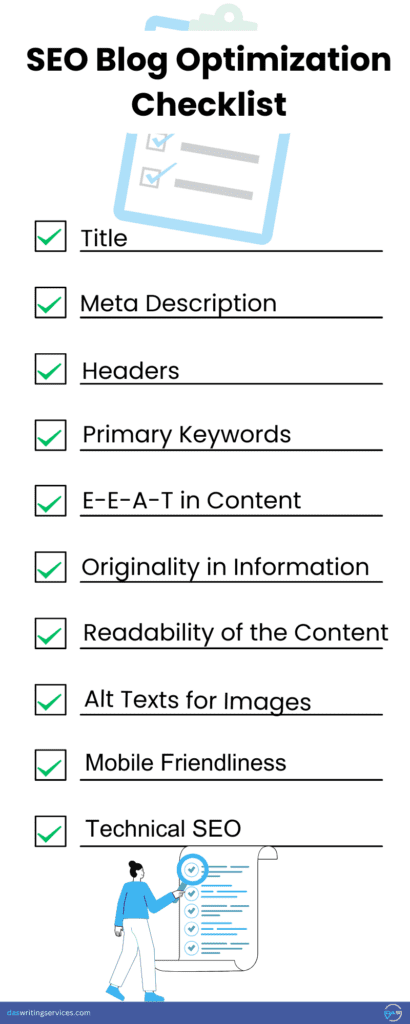So, you have set up a blog section on your website and all prepared to start your blogging journey. Whether you are a business or an individual trying to build a brand with wordpress, blogging is that one tool to reach the target group effectively.
Reason why content marketing has gained so massive popularity in 2024. Content Marketing Institute reports that roughly 58% of b2b marketers received increased sales with their content marketing efforts.
With proper Search Engine Optimization, the many benefits of blogging allows your site more visibility to receive more traffic.
While the world of SEO keeps changing, there are some timeless insider tips that are sure to help you make it big with SEO optimized blogs. Keep reading to find some interesting SEO blog writing tips that can help your site rank in the google search.
How to Create an Optimized Blog?
To run a successful blog that drives regular traffic one needs to take into account various factors – from keyword density, content length, LSIs, depth of information, formatting, there are virtually 30+ factors one needs to keep in mind while optimizing a blog.
One common feature between websites that create the best SEO blogs is they take care of all the ranking factors besides writing for humans. Here is a quick checklist for your reference about what you need to optimize for impactful results:

If you are still confused about how to write SEO blogs on your own, here are some practical tips that can help you.
10 Insider Tips for Writing SEO Blogs
Starting a new blog is one of the easiest thing you can do. Blogspot and wordpress both offer free websites that you can use to start your blogging journey. However, there are some unspoken rules to writing SEO optimized blogs. Irrespective of the fact if you are a business or an individual, the below mentioned tips and strategies should prove useful to create impactful blogs.
1. Conduct Proper Competitor Analysis
Yes, you guessed rightly! In the present-day scenario when everyone is focused on levelling up their digital marketing game, keeping an eye on your competitors is a must. It will help you understand their marketing strategy and formulate an even better plan to outrank them.
Wondering how to do so? Following are simple ways to conduct competitor analysis for search engine optimisation blogs!
- Study the SERP: Once you search with your brand keyword on the SERP, you will notice several sites ranking. These are your primary competitors. So, first and foremost it is essential to navigate to their sites and check their SEO strategies.
- Go for Keyword Gap Analysis: Running a keyword gap analysis will help you identify the keywords for which the competitor’s website is ranking but not yours. This way you can easily figure out the additional keywords to incorporate into your webpages.
- Conduct a Backlink Analysis: Various tools such as Ahrefs, Semrush, etc. can give you the necessary idea regarding the backlink strategy of your competitor. Make sure to leverage this data to identify the right backlink strategies for your website.
- Go Through Competitor’s Content: While performing competitor analysis, it is a must to check what your competitors are writing. Accordingly, make improvements in your content so that it becomes both the reader’s as well as search engine’s favourite.
2. Perform Keyword Research
The next essential strategy is choosing the most appropriate primary keywords and secondary keywords that align perfectly with the SEO blogs. For this, you can follow the below-mentioned steps:
- Check Keyword Relevancy: First, you will need to determine the keywords your competitor’s website ranks on and the ones your website ranks on. Then, using those as seed keywords, find some more relevant and appropriate keywords to craft compelling content.
- Evaluate the Keyword Metrics: Once you have chosen the keywords, you will need to check their search volume and keyword difficulty. Doing so ensures that your SEO blogs receives adequate traffic as well as ranks high on the Search Engine Results Page.
- Knowing the Search Intent: Scroll through the SERP to understand the intent of users behind searching for a key phrase. Remember that every user has a different intent behind searching for a query. The search intent can be navigational, commercial, informational, or transactional.
- Conducting a Thorough SERP Analysis: Skim through the SERP for your topic to conduct a thorough analysis of the SERP elements such as featured snippets, the People Also Ask section, and so on. This will help you get a clear idea when selecting keywords for your website.
- Selecting the Right Primary Keyword: Once you are done with the above steps, you can easily choose an appropriate primary keyword for your blog post. After that, you will need to place them in the right places such as in the meta tags, headings, introduction, and conclusion to optimise your blog.
3. Optimise Your Blog’s Title
The blog title is one of the most important elements of your SEO blogs that is needed to increase website traffic. Listed below are some of the effective ways in which you can optimise your blog’s title to get optimum results:
- Incorporate Numbers: Starting the blog with a number gives readers a clear idea regarding what they can expect from the blog. For example, you can add “11 Tips”, “5 Unique Ideas” and so on. Also, you can add the current year to give an idea about the relevancy and freshness of the blog to the reader as well as the Search Engine crawler.
- Use Sensory Words: Integration of sensory words brings your blog to life, helping the reader to be a part of the experience. It adds a vivid description to the H1 making it hard for the readers to not open and read through the blog. However, when choosing the sensory words, make sure that they align with the objective of the Title.
- Add Primary Keywords: Since the crawler crawls through the H1 when answering search queries, it becomes imperative to add the primary keyword. This ensures that your blog appears on the SERP when a reader searches for a query using the target keywords.
- Match the Topic with the Intent: Needless to say, it is essential for you as a writer to ensure that the blog topic perfectly aligns with the keyword that you are writing. Otherwise, if the reader finds that the content does not align with the title, they might switch to the next blog, with a negative impression of the overall website.
4. Start with an Engaging Introduction
The introduction is one of the primary elements of a search engine optimisation blog that helps you keep the reader engaged. So, it demands to be created with the utmost skill and attention. Wondering what can you do? Here are some simple ways to create an engaging introduction:
- Start with a Hook: Beginning your introduction with a thought-provoking question, some eye-opening information, or a strong opinion or point of view can immediately attract your reader’s interest, compelling them to read the entire blog.
- Use Personal Experiences: Incorporating relevant anecdotes or personal experiences can build an immediate connection with readers. However, make sure to keep it short, and crisp and use vivid language for your ease.
- Add a Preview of the Key Points: Previewing the points covered in your blog post will provide your readers with a sketch of what they can expect from the blog. This will, in turn, help in building their interests and keep them hooked.
5. Optimise Blog Subheadings
The primary function of the subheadings of a blog is to hold the attention of the readers. However, the headers also need to be SEO-optimised so that they can rank in the featured snippet or in the ‘People Also Ask’ section as and when needed.
Following are some ways in which you can optimise the subheads of your SEO blogs:
- Incorporate keywords: First and foremost, add relevant keywords to the subheads of your blog. This helps the blog perform well when the audience searches for related queries.
- Keep the subheads relevant: When framing the subhead, ensure that it aligns with the intent of the content. This is essential to maintain the flow of the blog and answer all the queries that might arise in the readers’ minds.
- Add numbers and sensory words: When framing a list of tips or steps, make sure that you add the number that they can expect in the subhead. Even you can add sensory words to immediately grab the attention of readers.
- Make the Subheads Descriptive: While writing the subhead check if it properly describes the content that they can expect under it. Otherwise, it can mislead readers, leading them to lose interest in your post.
6. Make Sure to Write for Your Audience
Search Engines these days rank those blogs high which answer readers’ queries. So, you must frame the content in a manner that can connect with your readers. Following are some ways in which you can make your blog easily readable by your target audience:
- Use Simple Language: When writing SEO blogs, identify the language that is popularly used by your target audience. This will help you connect with them easily.
- Keep the Sentences Variable: A mix of long and short sentences ensures that the blog is easily readable. Doing so will keep the readers engaged till the end of the blog.
- Incorporate Relevant Examples: While writing the blog, make sure to incorporate examples that your readers can actually relate to.
- Avoid Writing Fluff: Writing fluff is a strict no-no! It not only distracts readers but also unnecessarily increases the length of your blog.
To easily understand how you can craft an engaging blog for your target audience, check out some of the content writing examples.
7. Optimise the Meta Tags for Your Blog
The meta title and meta description associated with the blog play a crucial role in their ranking. This is so because Google crawlers scan the meta tags and rank those that have the targeted keywords. Below are some of the ways to optimising meta tags of your blog:
- Maintain the Length: Make sure to maintain the length of the meta title within 60 to 70 characters. Also, keep the meta description length within 155 to 160 characters.
- Incorporate Keywords: Integrate the target keyword appropriately in the meta tags to see a notable improvement in the blog’s ranking.
- Use a Number: When writing a blog containing a numbered list, mention it in the meta tags to attract readers to your blog.
8. Incorporate Necessary Links
Linking your SEO blogs to other websites or blogs can improve their ranking. However, you must be very cautious when choosing the anchor text, while hyperlinking to ensure that it does not appear forced or out of context.
Following are the types of links that you can incorporate in your SEO blogs to increase their authoritativeness:
- Links from other Sources: You can hyperlink an informative page to your blog such that your reader can get additional information by visiting the site. However, try to avoid linking your competitor’s site or blogs having similar content.
- Links from other pages of your Website: You can hyperlink one of your service pages or blogs when writing it. This practice ensures that those pages get some traffic from the readers who are landing on your blog.
- Links from Government Websites: Incorporating links from government websites can be helpful when you are writing finance-related blogs. This blog will help your readers to navigate the website without any hassle.
9. Incorporate Relevant Images and Videos
Images, infographics, and videos make it easier for readers to instantly summarise the SEO blogs. Also, you can optimise the image tags when uploading your blog such that readers can land on your blog even when they are just searching for images.
Furthermore, you can incorporate various YouTube videos into your blog that contain expert suggestions. You can even add videos from your own YouTube channel to make your blog simple and engaging.
10. Ensure Proper Addition of Tags
Once you are done with incorporating all the SEO strategies and content editing, the final task is to post it accurately. So, make sure to add all the title tags, heading tags, and image tags when posting the SEO blogs.
Doing so ensures that Google crawlers crawl through the right texts containing the appropriate keywords. Also, when posting ensure that there are minimal mistakes to ensure that they perform well on the SERP.
Takeaway
Crafting blogs for SEO is not much of a challenge if you properly incorporate these strategies. However, you should note that it would take some time for your blog to perform well on the SERP. So, it would be prudent to stay patient and keep monitoring your blog performance with the help of key performance indicators (KPIs).
Doing so will help you understand the areas where you can improve to enhance the ranking of your blog. Even, you can use Search Console to get valuable insights into your blog performance as per Google. Remember, organically ranking your blogs is not a sprint but a marathon, where you will need to bring in all your skills and efforts, but most importantly patience.
Subhodip Das is the founder and CEO of Das Writing Services Pvt. Ltd. He has an experience of 12 years in the field of Digital Marketing and specialises in Content Writing and Marketing Strategies. He has worked with well-established organisations and startups helping them achieve increased Search Engine Rank visibility. If you want to grow your business online, you can reach out to him here.




Leave a comment
All comments
Anupam
As a SEO content writer, I find this blog quite informative. It provides strategies on how to uplift the content from SEO perspective and bring in more traffic to the website, while attaining the position on the first SERP.
Sumedha Gupta Choudhury
This blog provides valuable information on how to scale up SEO writing. I would like your agency to curate more of such content to help ushering SEO writers like us gain insights.
Shaleen Guha Roy
This blog offers some valuable insights on optimisation techniques. The tips regarding meta-tag optimisation were particularly helpful. Will certainly use them in my own write-ups.
vinod gupta
Effective SEO begins with understanding your specific market and tailoring your keyword strategy accordingly.
Arghish Das
This is a really helpful article! I especially liked the tips on keyword research and writing catchy titles. How can I make sure my SEO blogs are both informative and engaging? Sometimes I feel like I have to sacrifice one for the other. I'm looking forward to more tips on how to write great blogs. Keep up the good work!